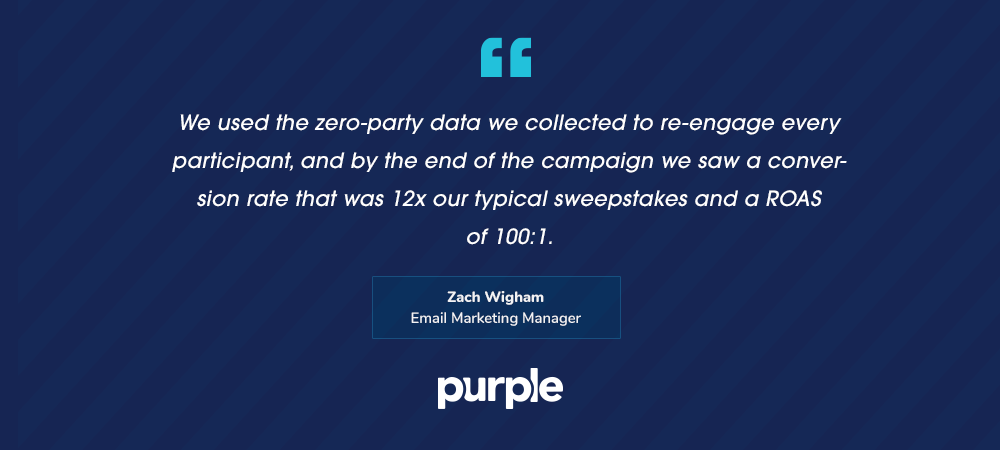What is the Difference Between First- and Zero-Party Data?

Knowledge is power, but with power comes responsibility.
For marketers, power means data—a critical ingredient to creating the kind of personalized marketing consumers want. And with mounting data privacy concerns, responsibility means being accountable and transparent with how you collect that data.
The most powerful data you can collect responsibly are first-party data and zero-party data. Both offer high quality without compromising privacy, but they are gathered and used in different ways. Here’s what you need to know about first- and zero-party data definitions, the differences, and how to use each to create personalized marketing experiences.
What is First-Party Data?
First-party data is information that you passively gather from user interactions. When considering a first-party data definition, remember that you’re collecting the information directly rather than outsourcing that step. This makes the data more accurate and reliable.
First-party data comes from your systems and platforms, such as your website, app, or social media pages. Typically, the most efficient way to gather first-party data is through a Customer Data Platform (CDP) or Customer Relationship Management System (CMS). Your brand will own everything, so as long as you are maintaining privacy best practices, everything should be safe and secure.
Examples of first-party data include:
- Purchase history
- Product preferences
- Behavioral data, such as clicks or time spent on page
- Links a user clicks on from email engagements
- Demographic information
- Social data
What is Zero-Party Data?
Where first-party data is passive, zero-party data is proactive. Consumers are not only allowing you to gather zero-party data, they’re choosing to share it with you for a specific purpose. Having this control gives consumers a great sense of security.
With zero-party data, there is typically a reciprocal exchange of value. Consumers opt to provide a certain type of information—such as their name, email address, and phone number—in exchange for something they want—such as a piece of gated content or a personalized offer.
Zero-party data comes straight from the horse’s mouth, so you know it’s accurate and reflects high consumer intent. And because consumers explicitly consent to share their data, the exchange fosters trust and transparency, making it more likely that the brand relationship will continue.
Examples of zero-party data include:
- Gated form fills
- Newsletter signups
- Quizzes
- Customer surveys
- Product preferences
- Purchase intentions
- Communication preferences
What is the Difference Between First-Party and Zero-Party Data?
The difference between first-party data and zero-party data comes down to how users grant consent. While first-party data is gathered passively via customer interactions, users intentionally hand over zero-party data.
Think about it this way. Your friend Steve’s birthday is coming up and you want to give him a gift. You could observe his behavior, then use that information to make an educated guess about what he would like. As long as you’ve been paying attention, your gift will please him, but there is room for error. That’s first-party data.
Alternatively, you could ask Steve directly, “What’s a gift you would like to receive?” If Steve answers, you will both definitively know that he will be getting a gift he likes. That’s zero-party data: you ask, they answer, and then they are rewarded for the information.
The difference between first-party data and zero-party data comes down to how users grant consent. While first-party data is gathered passively via customer interactions, users intentionally hand over zero-party data.
How Can Marketers Use First-Party and Zero-Party Data?
We’ve discussed the differences between first-party and zero–party data and why these forms are preferable to invasive collection methods. Now, let’s consider some ways that marketers can put these forms of data to use for campaigns that are both personalized and consent-based:
First-Party Data Examples
Purchase History
Gathering data on what customers buy (and what they leave in their cart) is a powerful way to predict what they might want to purchase next, helping you market to them effectively.
Example: Retail giant Target uses its Target Circle loyalty program to offer personalized offers based on customer purchase trends. This makes customers feel valued by Target and gives them rewards for the things they want to buy.
Behavioral Data
Collecting data that reflects how users interact with your platforms—such as clicks, time spent on a page, scroll depth, or devices they use when visiting your site—can give you actionable and profitable insights.
Example: Athletic brand ASICS uses both first- and zero-party data to deliver targeted campaigns. For instance, when a customer uses the ASICS Runkeeper app, the company knows they enjoy running and can promote relevant products, like running shoes.
But ASICS also combines that data with first-party data gathered through its OneASICS loyalty program to create additional marketing opportunities. For example, if ASICS knows that the runner also lives in a region with cold weather, it can market winter apparel to them.
Retargeting
Retargeting is about pursuing users who indicated an interest but didn’t act on it, such as viewing a product page but not actually buying the item. When first-party data reveals this, you can gently encourage them to complete the purchase.
Example: Examples of retargeting are numerous. To see it in motion, click on an ad on your social feed or visit a website and observe if an ad for that product or brand appears later. Some popular brands that use retargeting include Madewell, Nike, and Spotify.
Zero-Party Data Examples
Quizzes, Polls, and Surveys
Quizzes, polls, and surveys are a great way to get consumers to reveal what they’re looking for and who they are. Gamified systems can make this exchange fun—particularly if you offer a tempting little reward at the end.
Example: Apparel brand ThirdLove uses invited personalization to help its customers find the best bra for them. To this end, the brand created an optional quiz designed to help users figure out which product will suit their needs. This provides a dual benefit; shoppers have an easier time making purchase decisions and ThirdLove gathers valuable data it can use to refine offerings and marketing strategies.
Sweepstakes
Another fun way to engage consumers while gathering data is through identity marketing sweepstakes. Rather than having an open contest anyone can enter, you limit the contest to a specific consumer community: say, nurses or first responders. This makes the contest more appealing since it increases the odds of winning by narrowing the pool of entrants. It also encourages members to share the contest with others in the eligible community.
Example: Mattress brand Purple ran a sweepstakes campaign offering teachers, first responders, healthcare workers, and military members a chance to win a $1,000 gift card, and it was a smashing success. As Purple Email Marketing Manager Zach Wigham explained, “We used the zero-party data we collected to re-engage every participant, and by the end of the campaign we saw a conversion rate that was 12x our typical sweepstakes and a ROAS of 100:1.”

Loyalty Programs
Loyalty programs are an effective way to collect zero-party data because customers willingly share information about themselves in exchange for special perks. And when you also ask loyalty program participants to identify as members of specific consumer communities and verify their membership in that group, you gain even more insight.
Example: Crafts retailer Michaels’ loyalty program, Michaels Rewards, makes it easy for members to find and use exclusive discounts. After integrating SheerID’s Identity Marketing Platform with Michaels Rewards, the brand verified 200,000 customers in the senior, student, and military communities.
Membership Programs
When customers can become members of a brand’s exclusive network, they feel special. Brands can affirm that feeling by offering personalized perks and by asking members for their “expert” feedback. Membership programs are also a great way to gather first-party data, such as demographic information.
Example: Helly Hansen invites ski instructors, ski patrol, and professional athletes to enroll in its Pro Discount Program. This membership unlocks exclusive discounts and gives the company a way to canvas influential customers for product and brand insights. The result is troves of valuable data for Helly Hansen and first-rate treatment for pro customers.
Identity-Based Offers
Targeted discounts created specifically for a certain community spark a sense of excitement. It makes members of those communities feel valued and recognized for their role in society, and they are more likely to share the offer with others in their community. Most people will gladly self-identify as part of a community in exchange for an exclusive offer. This is what makes identity marketing one of the best ways to reward your customer base for self-attested data.
Example: Streaming platform TIDAL partnered with SheerID to offer discounts of 40-50% to students, military members, and first responders. The company found that customers who used these offers to subscribe to TIDAL had higher retention rates. So, while this promotional pricing means TIDAL collects lower monthly fees, it pays off by driving higher customer lifetime value.
Harnessing First- and Zero-Party Data
Modern marketers are performing a delicate balancing act: how can you maintain a high level of personalization without violating customer privacy? While it may seem like a catch-22, the solution is to gather data ethically and transparently. Doing so will not only put consumers’ minds at ease but will also result in higher quality data—a win-win for everyone involved.
If your brand is ready to tap into the power of first- and zero-party data, a great place to start is by finding your brand’s consumer communities and then targeting them with an offer just for them. SheerID’s Verification Platform makes it easy to acquire new customers and build long-term customer loyalty by confirming a customer’s membership in that community. This means the zero-party data you collect is verified. Most customers will happily provide the data you need to verify them, and you can use that data to continue implementing invited personalization and creating a happy, reciprocal relationship between your brand and your customer base.
Want to Learn More About Zero-Party Data?
Check out these resources:
- What is Zero-Party Data?
- Collect Zero-Party Data
- How ASICS Drives Double-Digit Growth with Zero-Party Data
You can also see how SheerID’s Verification Platform helps you collect zero-party data by watching this product video.